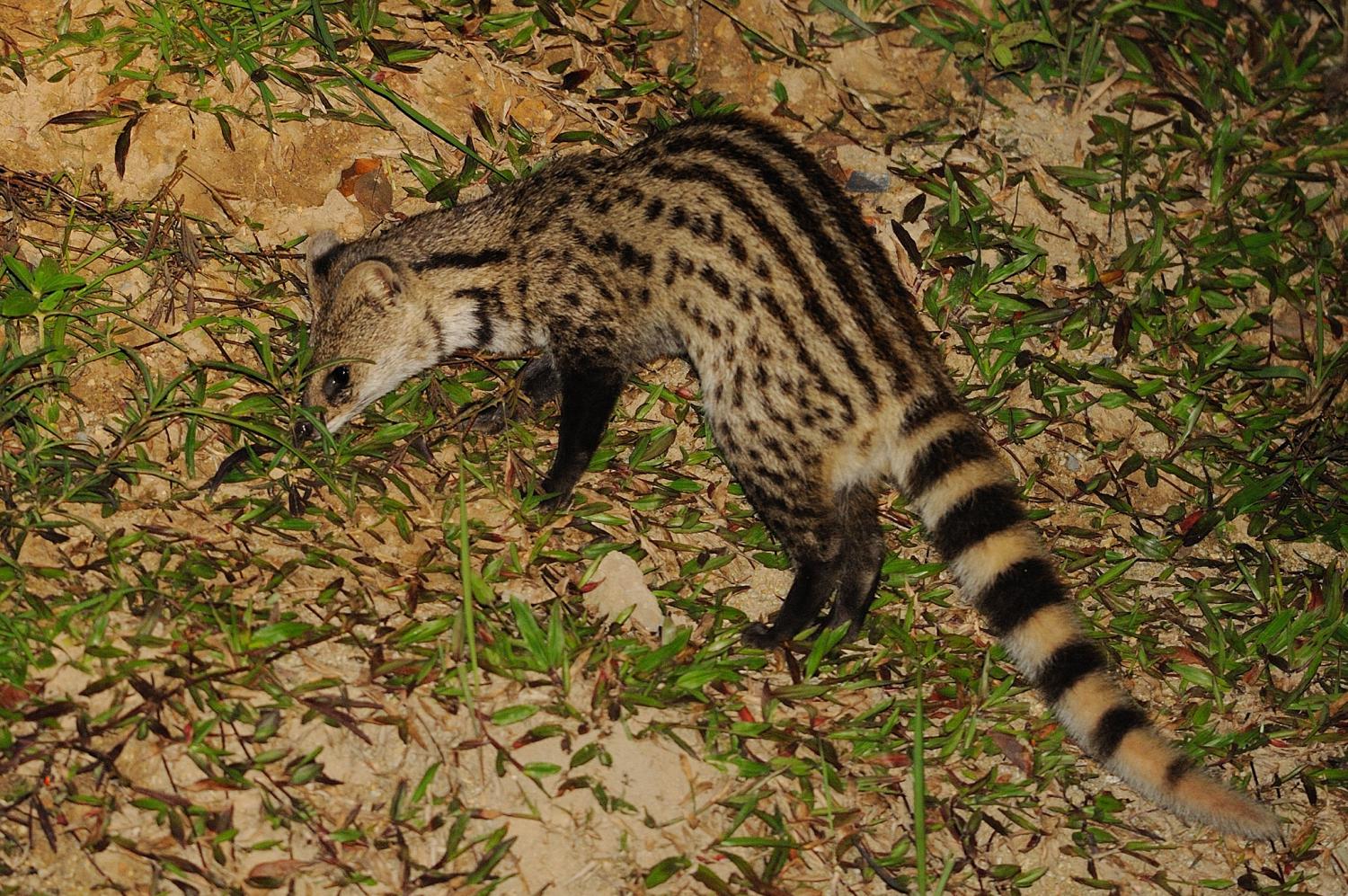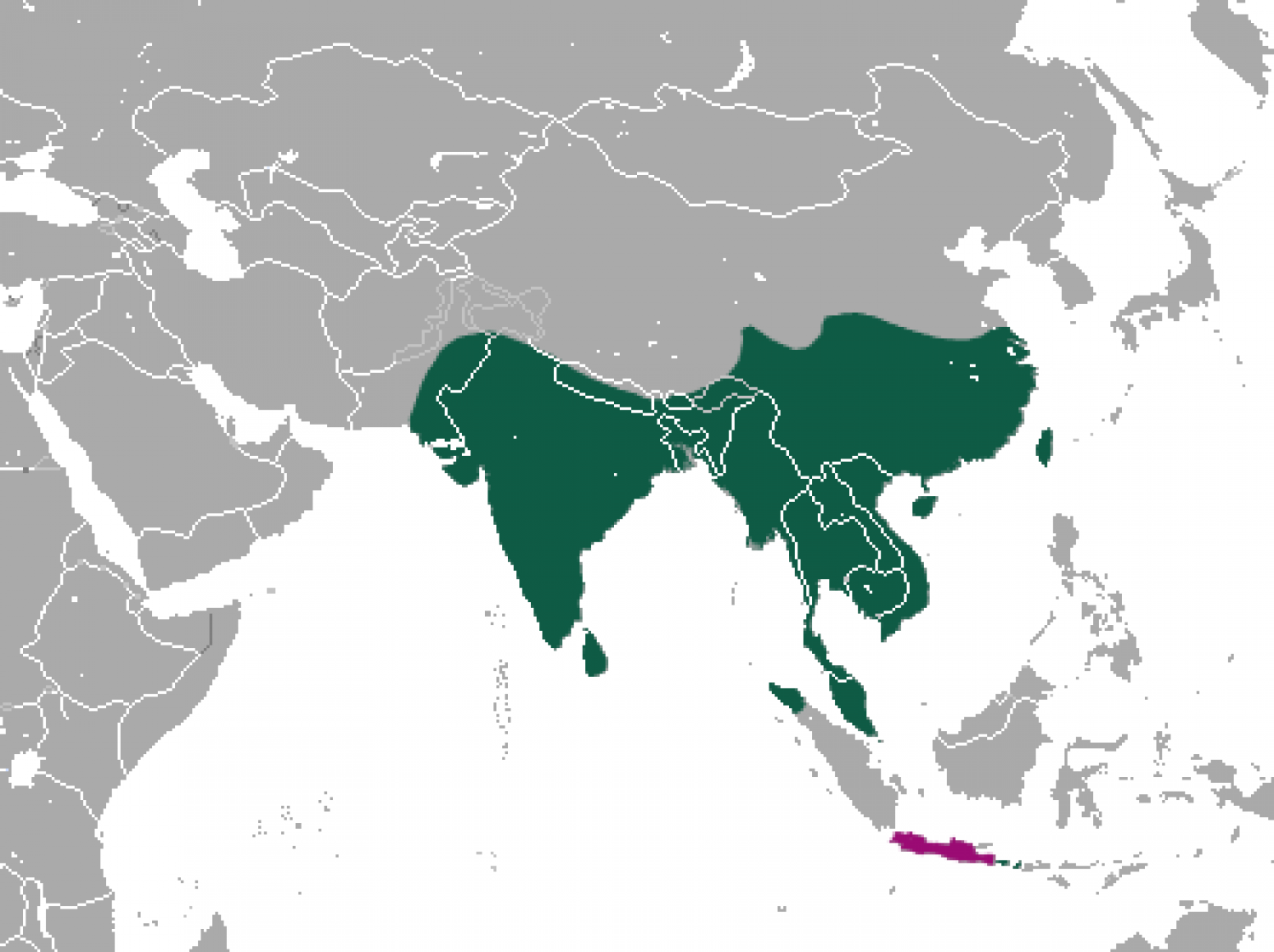Species of Thailand
Small Indian civet
Viverricula indica, Étienne Geoffroy Saint-Hilaire, 1803
(In Thai: ชะมดเช็ด)
The small Indian civet (Viverricula indica) is a civet found in South and Southeast Asia. It is listed as Least Concern by IUCN because of its widespread geographical distribution, widespread habitat use and healthy populations living in agricultural and secondary landscapes of many range states.
The small Indian civet is a monotypic genus.
Characteristics
The small Indian civet is 21 to 23 cm in head and body size and has a rather coarse fur that is brownish grey to pale yellowish brown, with usually several longitudinal black or brown bands on the back and longitudinal rows of spots on the sides. In some specimens both lines and spots are indistinct, and the dorsal bands are occasionally wanting. Usually there are five or six distinct bands on the back and four or five rows of spots on each side. The neck markings are rather variable. Generally there are two dark stripes from behind the ear to the shoulders, and often a third in front, crossing the throat. The underfur is brown or grey, often grey on the upper parts of the body and brown on the lower. The grey hairs on the upper parts are often tipped with black. The head is grey or brownish grey, the chin often brown. The ears are short and rounded with a dusky mark behind each ear, and one in front of each eye. The feet are brown or black. The tapering tail is 15 to 17 cm long with alternating black and whitish rings, seven to nine of each colour.
Distribution and habitat
Small Indian civets are known to occur in south and central China, Hong Kong, most of India, Lao PDR, Myanmar, Thailand, Viet Nam, Cambodia and Sri Lanka. No search has been made for recent records from Nepal, Bhutan, Bangladesh, Peninsular Malaysia, Java or Bali, areas where they were historically recorded. Their current status in Singapore is unclear. They have been introduced to Madagascar.
Small Indian civets have been recorded in semi-evergreen and deciduous forest, mixed deciduous forest, bamboo forest, scrubby areas, grasslands and riverine habitat.
Ecology and behavior
Small Indian civets are nocturnal, mostly terrestrial and insectivorous. They inhabit holes in the ground, under rocks or in thick bush.
Diet
They feed on rats, mice, birds, snakes, fruit, roots and carrion. Occasionally they carry off poultry.
Reproduction
The female has usually four or five young at a birth. The life span is eight to nine years.
Threats
People of Traspur village in Assam hunt it for meat and purify its skin into medicine.
Conservation
Viverricula indica is listed on CITES Appendix III. In Myanmar, it is totally protected under the Wildlife Act of 1994.
Taxonomic notes
Viverricula rasse described by Horsfield from Java is considered a variety of Viverricula indica.
This article uses material from Wikipedia released under the Creative Commons Attribution-Share-Alike Licence 3.0. Eventual photos shown in this page may or may not be from Wikipedia, please see the license details for photos in photo by-lines.
Scientific classification
- Kingdom
- Animalia
- Phylum
- Chordata
- Class
- Mammalia
- Order
- Carnivora
- Family
- Viverridae
- Genus
- Viverricula
- Species
- Viverricula indica
Common names
- German:
- Kleine Indische Zibetkatze
- Rasse
- English:
- Oriental civet
- Small Indian civet
- Spanish:
- Civeta enana
- Rasa
- French:
- Petite civette de l’Inde
- Civette rasse
- Civette Indienne
- Italian: Civetta indiana
- Dutch: Rassé
- Russian:
- Малая цивета
- расса
- Swedish: Liten indisk sibetkatt
- Thai: ชะมดเช็ด
Subspecies
Viverricula indica baptistæ, Reginald Innes Pocock, 1933
Range: Bhutan and Upper Bengal to Assam
Viverricula indica bengalensis, Thomas Hardwicke & John Edward Gray, 1832
Range: Northern India, south of the Ganges, from Calcutta to Gujerat and possibly Sind
Viverricula indica deserti, John James Lewis Bonhote, 1898
Range: Rajasthan (Indian)
Viverricula indica indica, Étienne Geoffroy Saint-Hilaire, 1803
Range: Southern India from the Western to the Eastern Ghats and as far north as Lake Chilka on the east coast
Viverricula indica mayori, Reginald Innes Pocock, 1933
Range: Sri Lanka
Viverricula indica muriavensis, Henri Jacob Victor Sody, 1931
Range: Java and Bali
Viverricula indica pallida, John Edward Gray, 1831
Range: Southern China and Taiwan
Viverricula indica thai, Cecil Boden Kloss, 1919
Range: Thailand, Indochina and Myanmar.
Viverricula indica wellsi, Reginald Innes Pocock, 1933
Range: Kangra, Kumaun and the United Provinces of India;
Synonyms
- Civetta indica, Étienne Geoffroy Saint-Hilaire (1803)
- Viverricula malaccensis non, Johann Friedrich Gmelin (1788)
Conservation status

Least Concern (IUCN3.1)
Photos
Please help us review our species pages if wrong photos are used or any other details in the page is wrong. We can be reached via our contact us page.
Range Map

- Hua Hin District, Prachuap Khiri Khan
- Huai Kha Khaeng Wildlife Sanctuary
- Kaeng Khoi District, Saraburi
- Khao Ang Rue Nai Wildlife Sanctuary
- Khao Sok National Park
- Khao Yai National Park
- Kui Buri National Park
- Mueang Krabi District, Krabi
- Phu Khiao Wildlife Sanctuary
- Salak Pra Wildlife Sanctuary
- Ta Phraya National Park
- Thong Pha Phum National Park


